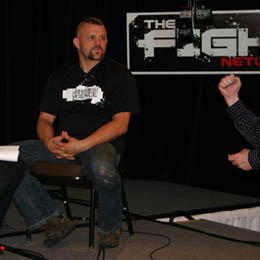So you’re a professional wrestling fan who doesn’t know much about mixed martial arts (MMA)? Or perhaps you’re at the other spectrum; a MMA fan who never quite understood the appeal of the choreographed mayhem that is pro wrestling.
The October launch party for The Fight Network in Toronto proved to be more than just an opportunity to schmooze with fight celebrities or to gawk at scantily-clad waitresses. In fact, it was a nexus point for fans of various forms of sporting combat, a reflection of a much larger demographic that this newly launched specialty channel will attract.

Chuck Liddell sits for an interview with The Fight Network. Photo courtesy The Fight Network
But it is a diverse mass that may very well soon acquire a new respect for other fighting spectacles, maybe even become a newly baptized fan. Be assured, The Fight Network’s co-founder Mike Garrow is all too aware of this potential phenomena taking place.
“I think there is a hope that fans will cross over,” said Garrow in an interview with SLAM! Wrestling. “At the end of the day, you have fans that are loyal to certain things and then you have fans that are willing to experiment with other things. That’s one of the luxuries of a 24-hour service like The Fight Network. You could be watching something like Ring of Honor and then all of a sudden, coming up next, Rumble on the Rock (an MMA event) from Hawaii. You may say to yourself ‘Oh that sounds interesting. I may have heard about it before but I’ve never seen it before. You know what, I think I’ll stick around and watch it.'”
“I think having those different disciplines on one network is really allowing the viewer to sample and that’s what it’s about,” Garrow continued. “If people become hooked on MMA stuff, great; all we’re there to do is deliver high impact, high action, 24-hours a day.”
While fighting purists may balk at the idea of pro wrestling being looked upon as any kind of peer, be assured, there is one competitor from the world of MMA who is all too aware of the crossover appeal of sports entertainment and his chosen sport.
His name is Chuck Liddell.
“There are a lot of fans with a similar interest in both,” remarked Liddell.
Liddell is the poster boy of North American MMA. He is the current reigning Ultimate Fighting Championship (UFC) world light heavyweight champion. While he may not look like the most imposing figure next to the muscled gargantuans of Vince McMahon’s World Wrestling Entertainment (WWE), Liddell is one of the world’s most feared strikers. The proof of that is in his win column, where victory after victory has come via knockout.
“With more television time and more back story, that’s more what the wrestling fans are looking for,” Liddell went on to say. “They want more back story. ‘Why are these guys fighting? Where do they come from?’ They’re not necessarily tuning in just to see two guys fight. I think that’s what the TV show did for people.”
The TV show Liddell refers to is The Ultimate Fighter (TUF) on Spike TV. Taking a page from the book of reality television, TUF features a group of mixed martial artists living under one roof, interacting, training and ultimately competing against one another in the caged octagon. The goal is simple — be the best fighter in your weight class and score a contract with UFC.
When the show was first launched, the lead-in show was WWE’s Monday Night Raw. While TUF attracted hardcore MMA fans, there was no mistaking the hope that wrestling fans would stick around and become avid viewers of the show where the fighting was quite real, while seeing first hand the personalities of the fighters.
No longer were they anonymous gladiators.
“Now, they’ve got a reason to watch these kids fight,” explained Liddell. “It’s not just two kids fighting, we know the back story, we know everything about them.”
“I’ve said since day one that UFC needs to do Ultimate Fighter,” said Bryan Alvarez, editor of the Figure Four Weekly newsletter and co-author of the book, The Death of WCW. He noted that TUF is the perfect vehicle to making MMA fighters into recognized fighting celebrities and generate a larger viewing audience.
“There is no downside to it whatsoever. If you make one star out of it, you’ve come ahead. In a good season, they’ll make a handful of stars,” said Alvarez. “Despite what some hardcore fans might say, a card with five stars on it will do better business than card with zero stars on it, even if those zero stars are the best fighters in the world.”
Of course, professional wrestling has its well established history of intermingling with various fighting personalities.
“Back in seventies and eighties, there was a great interest from the boxing world as far as wrestling goes,” noted Total Nonstop Action (TNA) wrestling star, Jeff Jarrett.
Long-time wrestling fans will recall vividly one particular famed incident, when boxer Muhammad Ali dared to tangle with the late professional wrestler, Gorilla Monsoon during a live event in Philadelphia in 1976. Ali found himself in the ring being airplane spun on the shoulders of Monsoon.
It would not be the last time Ali would find himself within a pro wrestling ring. Later that month, Ali would engage Japanese wrestling legend Antonio Inoki in the ring, in what was promoted as the first ever boxer versus wrestler match, in Tokyo, Japan. The match was a blatant work, ending in a draw. Years later, Ali would assume the role of main referee in the first ever Wrestlemania at Madison Square Garden.
“Muhammad Ali entered into the wrestling world, Leon Spinks did some refereeing, Joe Frazier, Ken Norton; there’s been different people from time to time that have done some crossover as a celebrity with their respective sport,” Jarrett went on to say.
So too has a crossover evolved from the world of MMA into professional wrestling.
Without a doubt, the greatest success story would have to be UFC star Ken Shamrock, who joined World Wrestling Federation (WWF) in 1997 during the height of the Monday night wrestling wars. A natural athlete with a great physique, Shamrock was a perfect fit, feuding with all the major stars of the company at that time, utilizing the ankle lock as his finishing hold. During his tenure, Shamrock held the Intercontinental title and the Tag Team championship, along with The Big Bossman.
Ken Shamrock
“Shamrock started out as a pro-wrestler years before he got into fighting,” noted Alvarez. “When he started with WWE he picked it up again very fast. He actually turned into a really good worker and adapted to the WWE style, meaning he did more than just shoot-style stuff.”
Shamrock would not be the only MMA celebrity to venture into the wrestling world. Dan “The Beast” Severn also wrestled for WWF, while David “Tank” Abbott would appear on the radar via World Championship Wrestling (WCW). Neither one, though, would reach the heights of success that Shamrock achieved.
“Severn didn’t have the right kind of personality for WWE and I don’t think they really had any idea what to do with him. Tank Abbott had an amateur background but made his name in UFC brawling. He never learned to work at all and was a victim of Vince Russo’s wackiness in WCW,” said Alvarez.
Tito Ortiz
Recently, Tito Ortiz of UFC fame has appeared with TNA in the role of a main event referee. In a September interview to promote his appearance with TNA, he talked to the Orlando-based Between the Ropes radio show. Ortiz said that he was a wrestling fan growing up, loving The Junkyard Dog, Ted DiBiase, Hulk Hogan, and Hacksaw Jim Duggan. He said that the showmanship he picked up from the wrestlers helped him garner a reaction in UFC’s octagon.
But has this crossover of MMA fighters converted and educated wrestling fans to MMA? In the case of WWE, according Alvarez, it has not.
“They (fans) respond mostly to what WWE trains them to respond to. An ankle lock gets over because Kurt Angle does the ankle lock and everyone submits to it,” Alvarez said. “A triangle by Undertaker doesn’t get over because WWE has never trained the fans to accept that as a finish because no one ever taps to it. And it was the same thing when Shamrock was in WWE.”
There is no dispute that professional wrestling has mastered the art of developing larger-than-life personalities that can attract an audience. Likewise, with a program life TUF, gaining insight into the personalities that are driven to partake in MMA is playing a more serious role in countering media outlets hell bent on portraying MMA as nothing more than a human cock fight.
“They’re ignorant,” said Liddell bluntly about those who criticize MMA without doing their homework. “We’re not a bunch of meatheads. They try and paint us as Neanderthals out there beating on each other. We’re going to run with that problem for a while, but the more popular it gets, the more it’s on TV, there more sponsors get behind it, the less that’s going to matter. Three of the four title holders in the UFC have college degrees. We’re not dumb people, we’re not vicious people, we’re not mean people.”
Mike Garrow. Courtesy The Fight Network
For some fight purists, having professional wrestling on board The Fight Network may be considered an affront. But in developing the specialty channel, Garrow assured that no voices of descent spoke out loud.
“We explained to all the different programming partners what the different genres that would be on (the channel). Nobody said anything about anything,” said Garrow.
“All they wanted to know, and rightfully so, is how we were going to deal with their individual shows and events and how we were going to make certain things for them special. I think, so far, that’s what we’ve done.”
“To be honest, I’m a fan of pro wrestling,” admitted Garrow. “I think to truly round out a service like The Fight Network, you got to have all these disciplines and I’m happy that pro wrestling is in the mix.”
MORE FIGHT NETWORK STORIES
- Oct. 6, 2006: Devine: Networking at a Fight party
- July 6, 2006: Fight Network reaches the top
- Oct. 22, 2005: Fight Network starts swinging at launch party
- Jan. 28, 2005: Fight Network takes the fight to the fans

